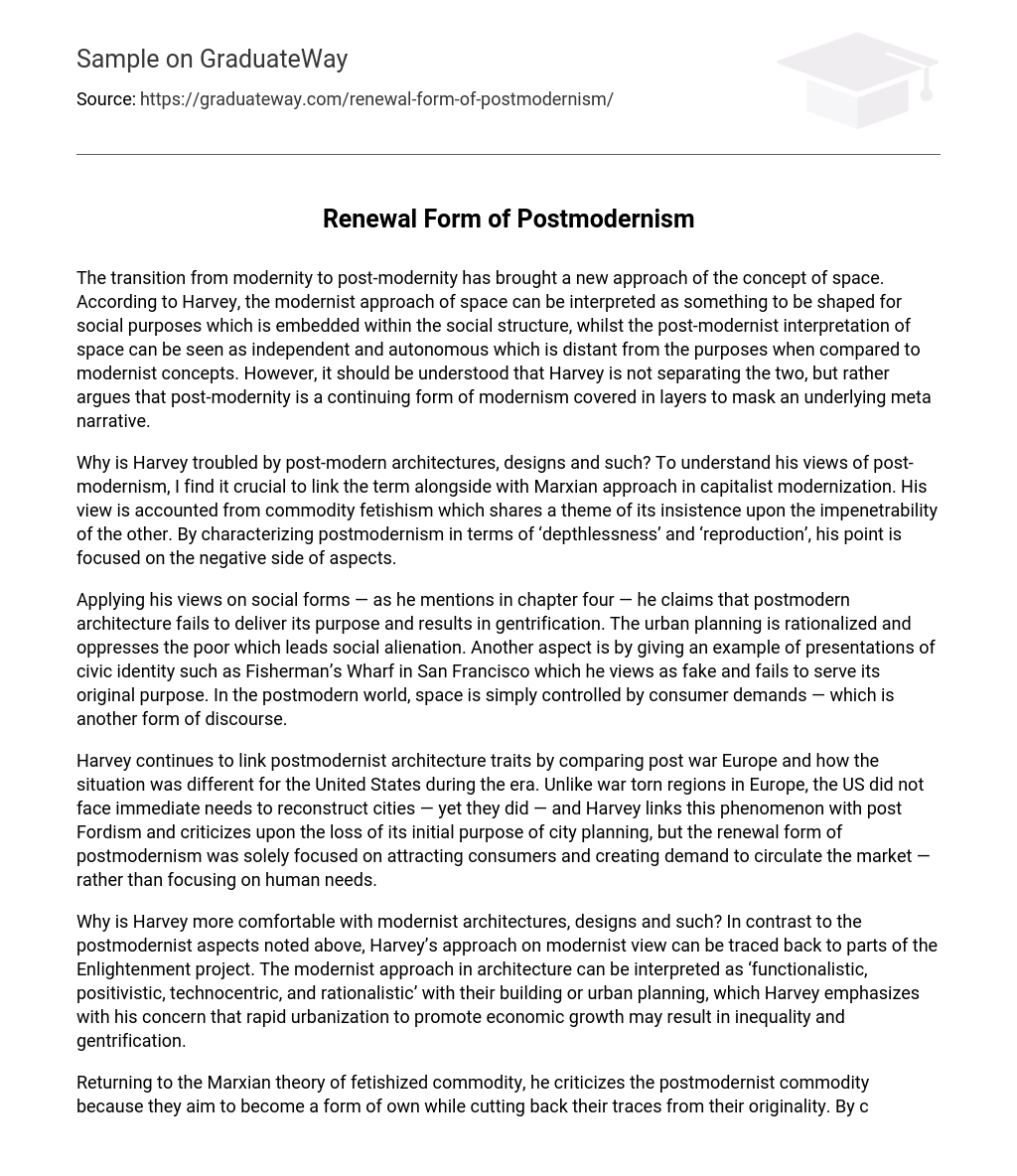The transition from modernity to post-modernity has brought a new approach of the concept of space. According to Harvey, the modernist approach of space can be interpreted as something to be shaped for social purposes which is embedded within the social structure, whilst the post-modernist interpretation of space can be seen as independent and autonomous which is distant from the purposes when compared to modernist concepts. However, it should be understood that Harvey is not separating the two, but rather argues that post-modernity is a continuing form of modernism covered in layers to mask an underlying meta narrative.
Why is Harvey troubled by post-modern architectures, designs and such? To understand his views of post-modernism, I find it crucial to link the term alongside with Marxian approach in capitalist modernization. His view is accounted from commodity fetishism which shares a theme of its insistence upon the impenetrability of the other. By characterizing postmodernism in terms of ‘depthlessness’ and ‘reproduction’, his point is focused on the negative side of aspects.
Applying his views on social forms — as he mentions in chapter four — he claims that postmodern architecture fails to deliver its purpose and results in gentrification. The urban planning is rationalized and oppresses the poor which leads social alienation. Another aspect is by giving an example of presentations of civic identity such as Fisherman’s Wharf in San Francisco which he views as fake and fails to serve its original purpose. In the postmodern world, space is simply controlled by consumer demands — which is another form of discourse.
Harvey continues to link postmodernist architecture traits by comparing post war Europe and how the situation was different for the United States during the era. Unlike war torn regions in Europe, the US did not face immediate needs to reconstruct cities — yet they did — and Harvey links this phenomenon with post Fordism and criticizes upon the loss of its initial purpose of city planning, but the renewal form of postmodernism was solely focused on attracting consumers and creating demand to circulate the market — rather than focusing on human needs.
Why is Harvey more comfortable with modernist architectures, designs and such? In contrast to the postmodernist aspects noted above, Harvey’s approach on modernist view can be traced back to parts of the Enlightenment project. The modernist approach in architecture can be interpreted as ‘functionalistic, positivistic, technocentric, and rationalistic’ with their building or urban planning, which Harvey emphasizes with his concern that rapid urbanization to promote economic growth may result in inequality and gentrification.
Returning to the Marxian theory of fetishized commodity, he criticizes the postmodernist commodity because they aim to become a form of own while cutting back their traces from their originality. By creating false advertising, postmodernist commodities aim to sell itself not by meeting individual needs, but by creating wants which results in overproduction and overaccumulation of capital.
Harvey confirms this by saying that ‘advertising and commercialization destroy all traces of production in their imagery, reinforcing the fetishism that arises automatically in the course of market exchange.’ In his view, modernist forms of art serve purposes which holds humanitarian value — which contrasts from postmodernist forms of art, where its purposes are focused on creating demand and accumulation.
Harvey’s characterization of postmodernity is strongly linked with capitalism, as his views upon those two are inseparable in order to understand the mechanism. His views on the modern world is dominated by the capitalistic influence which is derived from the hegemonic state form. In short, Harvey’s idea of modernism and postmodernism is based upon a continuity where people are living in a same time and space in the era of capitalism and technology.
Postone, on the other hand, does not agree with Harvey. His argument against Harvey is that his approach to capitalism is merely one dimensional and interprets capitalism effects as space and time compressions. The main part of the critique lies on Harvey’s analysis of capitalism that Harvey understood capitalism was incapable of change, but rather reached a state of its end.
Postone points out that postmodernism and capitalism indeed can be linked together, but in a sense of an ongoing form of post capitalism. Going deeper, Postone retreats back to Marxian base theory of the flaws of the market system and suggests a different dimension of capitalism — pointing out to a new potential global form of political decentralization and heterogeneity of production and consumption with increasing centralization of control and underlying homogeneity.
His view implies that postmodernism may suggest an answer to capitalism in a sense of emancipatory change, which can be understood as a fusion of social life with capitalism. It suggests a potential answer and guide to the past historic flaws of capitalism and shaping a new mode of post capitalism where traditional Marxism and postmodernism (can be understood as capitalism as well) come to an understanding and settle at a middle ground.





